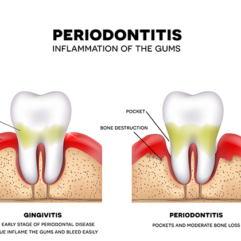Root Canal Treatment (RCT): What You Need to Know
The Procedure, Benefits, and Costs of Root Canal Therapy
Root canal treatment (RCT) preserves a dead or infected tooth in the mouth. Root canals are usually treated by an Endodontist, a specialist who has had special training in this field of dentistry. Some general dentists will perform a root canal on a simple-to-diagnose, single-rooted tooth. However, Endodontists can meet the challenges of diagnosing a problematic tooth and distinguishing between a dying tooth and one that can recover. The specialist is also more experienced in thoroughly removing the infection with a high success rate.

Don’t let root canal pain hold you back! Seek treatment and restore your smile and comfort
A root abscess can be a painful experience caused by an infection exiting the root and preventing bone growth. Other issues, such as fistulas, pimple-like bumps, and deep cavities, can also result in discomfort. Root canal treatment is often necessary to save a tooth from decay or damage, and an endodontist with specialized training typically performs it.
Beyond Borders Dental connects patients with reputable, affordable endodontists in Mexico who provide high-quality root canal treatment. These specialists can diagnose problematic teeth and determine the best action to save them. Pain associated with root canal issues can manifest in various ways, including lingering pain, positional pain, spontaneous pain, and referred pain.
Indicators for Needing a Root Canal–Severe Pain!
A root canal is a therapy to repair and save a tooth that is badly decayed or infected. A tooth’s nerve and pulp can become irritated, inflamed, and infected due to deep decay, repeated dental procedures on a tooth, large fillings, a crack, or a chip in the tooth. It also can happen because of trauma to the face.
Types of Root Canal Pain
Is pain just pain? Your dentist should inquire about the following four types of pain. Here are four types of pain associated with root canals.
- Lingering pain: Occurs when a tooth is activated by a stimulus, like hot tea or ice cream, and persists without relief. It may lead to sensitivity lasting for an hour.
- Positional Pain: This is when your pain worsens if you lie down suddenly, stand up, or exercise heavily.
- Spontaneous Pain: Occurs if a wave of pain occurs out of the blue with no apparent cause.
- Referred Pain: If pain travels from your tooth to other parts of your mouth and beyond.
Common Causes of Pain Associated with Root Canal Cases
- Abscess: An abscess is most commonly diagnosed with X-rays. It shows up as a dark or blackened spot at the bottom of the root (the apical) on the bone. An abscess is formed when the infection from the tooth exits the bottom of the root, and bone can’t grow around it.
- Fistula: A fistula on the gum or the palate is a white, yellow, or red pimple-like bump. The infection tries to find a weak spot in the mouth to escape.
- Deep Decay: If a cavity is too close to the pulp (the nerve chamber).
How Necessary is it to Treat a Tooth Needing a Root Canal?
If you are in pain, an endodontist will prescribe antibiotics for the infection. When you experience some relief from the pain, know the antibiotic has not healed the tooth. It will only be a matter of time before the tooth flares up again. The antibiotics immediately begin to attack the infection in your body, an infection that could spread to your heart or brain, which could be deadly.
Our dentists also usually prescribe antibiotics before treating a root canal because they decrease the tooth’s inflammation, which assists in the anesthesia numbing effect. Do not let the relief of the antibiotics fool you! So, yes, a diseased tooth must be treated, or the infection can kill you. Root canal treatment is often the most straightforward and quickest option in treating a tooth.
The Root Canal Procedure
- Anesthesia is given. Even with prior antibiotics, sometimes it takes a little longer for a tooth needing a root canal treatment to numb.
- The dental dam is placed. A rubber frame is attached to the tooth to isolate it to be as sterile as possible and block any bacteria from the mouth.
- A small access hole is drilled, either from the back of the tooth or the top. If the tooth already has a porcelain-to-metal or ceramic crown, the hole is drilled through the crown material without removing the restoration.
- The diseased pulp tissue and nerves in the canals are removed. The canals are then carefully cleaned out with several individual precision tools.
- The canals are disinfected with antiseptic and antibacterial solutions.
- The canals are shaped and prepared for the filling material.
- Gutta Percha, a rubber-like material, is used to fill the canals. The filling material is heated and compressed into the canal walls, and an adhesive cement is used to seal the Gutta Percha. The cement is crucial in preventing re-infection.
- A temporary filling is placed.
- If the tooth weren’t crowned, you would return to your general dentist for a dental crown treatment. A crown is necessary because the tooth becomes brittle after the nerves are removed. For the tooth to withstand the force of chewing with its opposing tooth, it must be protected and strengthened with a dental crown, or else the tooth can break.
The Importance of Precision and Expertise in Root Canal Treatment

Illustration of a root canal treatment.
A root canal treatment demands precision and a highly skilled endodontist to remove the infection. It is a challenge to clean the canals out 100%, as many small accessory canals branch off the main ones. The root canal treatment has a 95% success rate among endodontists. However, it is essential to know that the only way to guarantee the removal of the infection is 100% by extracting the infected teeth.
Most people do go on to live healthy and vital lives after a successful root canal treatment. It is still crucial to discuss with your dentist or Endodontist their confidence in treating your particular tooth and all other possible treatment options.
Many people today are opting for extractions and dental implants. Regardless of your decision, dentistry for root canals and implants is much more affordable in Mexico than in the US.
Things to Know About Root Canal Therapy
Getting a root canal is no picnic. First, there’s the pain that causes you to realize something is WRONG. This may be a mild twinge when you bite down or a shooting pain that leaves your whole body aching, and you wish you didn’t have teeth in the first place.
Whatever the case, living with the pain is not an option. You must get treatment as quickly (and painlessly) as possible. If you’re currently searching for a dentist in your area for a root canal, here are a few things you need to know.
- A root canal is performed when the pulp inside the root of your tooth needs to be removed and replaced with artificial material. This could be due to decay, infection, or injury.
- During a root canal, a pathway is created from the tooth’s crown to the root canals holding the damaged pulp. The damaged pulp is then carefully removed. The area is thoroughly cleaned to remove debris, and the canals are filled with permanent material. The tooth is sealed, and a permanent crown is cemented in place over the new tooth root.
- A dentist cannot cure a root canal with antibiotics. It’s not unreasonable to think that antibiotics can heal a bacteria-based infection; however, since the area inside the tooth is damaged, antibiotics cannot access the affected area.
- Your root canal procedure will probably not be performed by your general dentist in the US. Root canals are often treated by specialists called endodontists. However, your dentist can sometimes perform them, depending on their qualifications and experience level.
- Depending on severity, A root canal takes between 30-90 minutes.
- A root canal should not hurt. Local anesthesia prevents you from feeling the pain of the procedure.
- You may think you don’t need a root canal because your tooth pain has subsided; this does not mean your tooth has healed. As the pulp inside the tooth becomes more infected, it eventually dies, causing the pain to subside. You still need to treat the area to prevent it from becoming more dangerous to your health.
- You might be sore after the procedure. For a few days, avoid putting too much strain on the tooth. You can typically alleviate the pain with an over-the-counter painkiller. Ask your dentist if you think you need a prescription painkiller.
- Proper after-care is essential. If your dentist has given you a temporary filling, you will get a permanent crown later. In this case, you need to protect the temporary filling, which is at risk of fracturing. Try to avoid chewing or biting with it until you get your permanent crown.
- If done correctly, a root canal should never need to be redone. However, the dental crown will likely need to be replaced after 10 to 15 years.
- It could save your smile (and the rest of your teeth). If you let a root canal go too long without treatment, you may need to remove the entire tooth. This can cause your other teeth to shift, which can affect your bite and your smile.
- You have another option for an affordable root canal. you can travel to Mexico and get one from a licensed dentist. This practice, called dental tourism, saves most people 50% to 75%. In fact, the cost of a root canal in Mexico averages about $300.00.
Getting a Root Canal in Mexico
A root canal treatment in Mexico typically involves local anesthesia, removal of diseased pulp tissue and nerves, cleaning and disinfecting the canals, and sealing them with filling material. This treatment is crucial for repairing and preserving teeth affected by decay, trauma, or other issues.
While the success rate of root canal treatment is high, extractions and dental implants are also viable options for tooth restoration.
Endodontists in Mexico use state-of-the-art equipment and materials comparable to those used by US dentists. Patients who have sought dental care in Mexico report high levels of satisfaction with the quality of treatment they received. Root canal treatment usually requires two to three visits, depending on the infection’s severity and difficulty.
After undergoing root canal treatment, patients may experience some soreness, which can be managed with proper after-care and medication. Following up with a dentist to ensure the tooth heals effectively and discuss further treatment options, such as dental crowns or implants, is essential. The cost of root canals in Mexico is significantly lower than in the US, making it a more affordable option for individuals seeking quality dental care.
In Mexico, patients undergoing root canal therapy can benefit from skilled endodontists, advanced technology, and cost-effective treatment options. Beyond Borders Dental strives to provide clients access to top-notch dental care at a fraction of the cost, ensuring that smiles are restored and teeth are saved effectively.
How Much Can I Save on a Root Canal Through Beyond Borders Dental?

You Can Save Hundreds of Dollars on Just One Root Canal in Mexico.
Whether you need an affordable option for root canal treatment, the price of the root canal treatment depends on the number of canals in the tooth and who performs the procedure.
An Endodontist in the US can charge anywhere from $1,000.00 (single-rooted tooth) to $1,800.00 (difficult and four-rooted teeth). With Beyond Borders Dental, you can get a much more affordable root canal by taking a short trip to Mexico.
Our Mexico border dentists charge around $250.00 – $300.00 for root canal treatment, which is much cheaper than the most simple root canal treatment in the US. Remember, the Endodontists in Mexico are specialists who solely treat root canals and are as focused as any Endodontist worldwide can be on the skill it takes to treat infections successfully.
Whether you are getting a root canal treatment in the US or Mexico, most often, it is routine for the root canal treatment to take two visits. However, they can range anywhere from one to three appointments. The procedures are broken up based on the difficulty of treatment, such as more roots than expected with a tooth and the severity of infection.
Visit the American Association for Endodontists website for additional information on root canal treatments.
If you have questions or need additional information, please Contact Us or Request a Quote to send us your dental inquiry, and we’ll get back to you.










